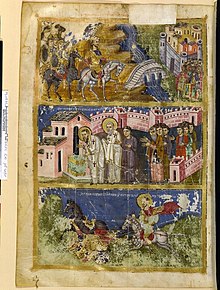Battle of Ctesiphon (363)
This article needs additional citations for verification. (May 2011) |
| Battle of Ctesiphon (363) | |||||||
|---|---|---|---|---|---|---|---|
| Part of Julian's Persian expedition | |||||||
 Julian near Ctesiphon; medieval miniature | |||||||
| |||||||
| Belligerents | |||||||
|
Arsacid Armenia | Sasanian Empire | ||||||
| Commanders and leaders | |||||||
|
Julian |
Surena Pigranes Narseus | ||||||
| Strength | |||||||
| 60,000[1] – 83,000 men[2] | Presumably larger than Roman force[1] | ||||||
| Casualties and losses | |||||||
| 70[1] | 2,500[1] | ||||||
The Battle of Ctesiphon took place on 29 May 363 between the armies of
Background
On November 3, 361,
Turning next to foreign policy, Julian saw the previously unchecked military incursions of Shapur II of Persia against the Eastern Roman provinces as posing the greatest external threat. After many failed earlier attempts, the Persian king launched a more successful second campaign against the Romans and captured
With Julian's reputation and exploits during his years as Caesar and general of Gaul preceding him, Shapur preferred to negotiate a peace treaty with the intrepid young Julian. Believing it to be incumbent on himself to produce a more permanent settlement in the East, Julian responded to Shapur's calls for peace by saying that the Persian king would be seeing him very soon and began preparing for an expedition against the
The battle
Seeing Julian successfully march into his dominions, Shapur ordered his governors to undertake a scorched earth policy until he reached the Sassanid capital, Ctesiphon, with the main Persian army. However, after a few minor skirmishes and sieges Julian arrived with his undefeated army[7] before Shapur II to the walls of Ctesiphon on May 29.
Outside the walls a Persian army under Merena was formed up for battle across the Tigris. According to Ammianus Marcellinus, the Persian army featured cataphracts (clibanarii), backed up by infantry in very close order. Behind them there were war elephants.[8]
Julian's force attempted to set foot on the opposite shore of Tigris, under harassment by the Persians.
Aftermath

Reluctantly, Julian agreed to retreat back along the Tigris and look for Procopius and the other half of his army that had failed to coordinate the double-pincers movement with him outside of Ctesiphon as had been planned. On 16 June 363, the retreat began. Ten days later, after an indecisive Roman victory at
Citations
- ^ a b c d e Tucker 2010, p. 160.
- ^ Shahbazi 2005.
- ^ Browning 1978, p. 243.
- ^ Zosimus, Historia Nova, book 3, chapter 12. Zosimus' text is ambiguous and refers to a smaller force of 18,000 under Procopius and a larger force of 65,000 under Julian himself; it's unclear if the second figure includes the first.
- ^ Elton, Hugh, Warfare in Roman Europe AD 350–425, p. 210, using the higher estimate of 83,000.
- ^ Bowersock, Julian the Apostate, p.108.
- ^ Lieu & Montserrat 1996, p. 208.
- ^ Ammianus Marcellinus, Res Gestae, Book 24, 6.3 το 6.8.
- ^ Ammianus Marcellinus, Res Gestae, Book 24, 6.10 to 6.12.
- ^ "Battle of Ctesiphon | Summary | Britannica". www.britannica.com. Retrieved 2023-01-11.
General and cited references
- Bowersock, Glen Warren. Julian the Apostate. London, 1978. ISBN 0-674-48881-4
- Browning, Robert (1978). The Emperor Julian. University of California Press. ISBN 9780520037311.
- Lieu, Samuel N.C.; Montserrat, Dominic (1996). From Constantine to Julian: Pagan and Byzantine views: A Source History. Routledge.
- Shahbazi, A. Shapur (2005-07-20). "Sasanian dynasty". Encyclopedia Iranica.
- Tucker, Spencer C., ed. (2010). A Global Chronology of Conflict. Vol. 1. ABC-CLIO.
- Wacher, J.S. (2001). The Roman World. Vol. 1 (2 ed.). Routledge.
